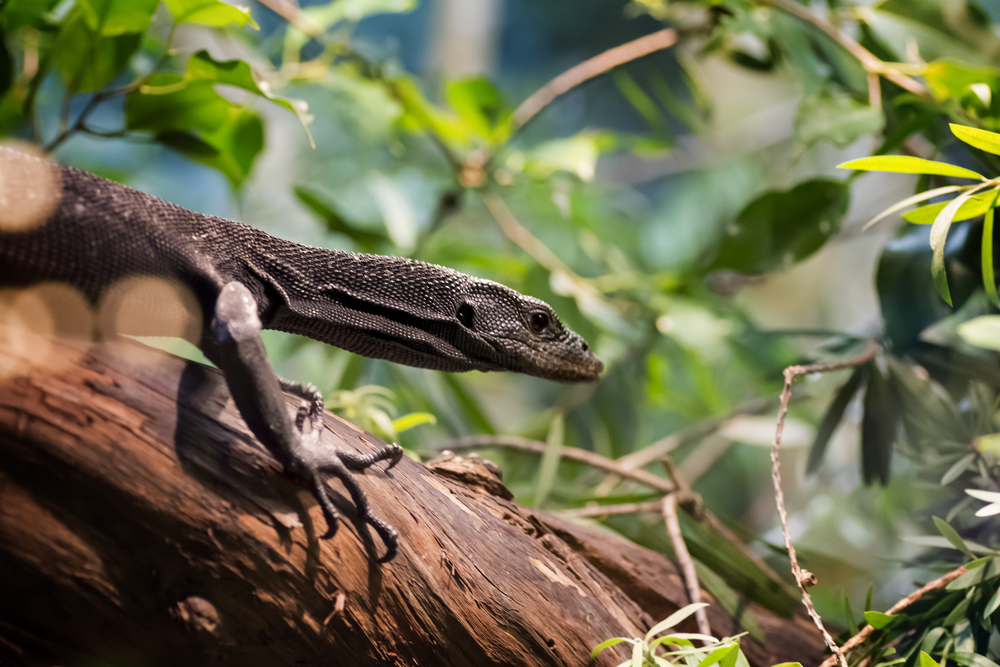Black Tree Monitor Maintenance and Care
24th Nov 2015

When it comes to pets, there are two types of owners: those who like to take care of their pets and those who like their pets to take care of them. This, of course, refers to the physical bond between pet and owner, the latter preferring animals that they can hold and cuddle while the former usually likes to observe their pets and cultivate a realistic environment for them. On this spectrum falls spiders, snakes, and lizards, and the Black Tree Monitor is certainly the type of animal that benefits from a “look, don't touch” lifestyle. If you're the kind of pet owner who is looking for something truly unique and captivating, the Black Tree Monitor is an excellent option. It does require more time, effort, and money man most lizard species, however, so make sure that you can devote enough care and attention to your Monitor to ensure a happy and healthy lizard. Below we’ll outline the proper steps needed to care, feed, and house this exotic creature.
Housing
Black Tree Monitors are native to Papua New Guinea, so they hail from a warm, tropical climate. It is imperative that you maintain a realistic jungle-style environment for the health and welfare of your monitor. This species is relatively small, ranging from 32 to 48 inches, with the male being the larger of the sexes. Most of this length is made up of a semi-prehensile tail, which the Monitor uses to climb and stabilize itself in the trees.
When it comes to your enclosure, the habitat should consist almost entirely of branches and climbable surfaces. The Black Tree Monitor rarely descends from the canopy to the ground, so you want to skimp on the substrate and focus on the foliage. That being said, Monitors do like to swim in ponds and streams, so it will be a great benefit to your pet to have a large, shallow water bin on the ground. It will require almost daily cleaning, though, so be sure to check it regularly.
As far as size of the enclosure, Monitors, as with all exotic pets, benefit from more space. Ideally, your habitat will be at least six ft tall, at least five ft wide and three ft deep, but if space is something you cannot provide, most experts would agree that a 4x4x2 area is the minimum you can provide. The habitat can be an open-air enclosure or a glass terrarium. As long as you provide a shady spot and plenty of branches, your Monitor will thrive.
When it comes to replicating the Monitor’s natural environment, you want to make sure that the temperature ranges from the low 70s to mid-80s, with the low 90s being on the high end. Humidity is also crucial, and should hover around 60%. If your enclosure is inside, you need to be able to provide a natural day/night cycle, with at least eight hours of simulated sunlight. If you choose to have your enclosure in an area that gets sunlight, just make sure the Monitor has a shady spot to avoid overheating.
Feeding
The Monitor, like most reptile species, has a varied diet. In the wild, they eat everything from insects, rodents, smaller lizards, snakes, and the occasional bird. Obviously you won't be able to provide such a diverse range of animals, but a mixture of rodents and insects should suffice in providing your Monitor with all the nutrients they need. In addition to the animals, which can be fed alive or dead, you should dust their feed with a calcium powder or liquid. Since most Monitors are captured in the wild and few are bred in captivity, it is usually best to feed your pet live animals, to better mimic their natural habitat. However, if you are looking to tame your Monitor or can’t get live feed, then dead bait will suffice. If you are using insects, a great option is Dubia Roaches, which are bred for maximum nutrients and protein. Dubia Roaches are also very docile, so it’s easy to insert them into the habitat alive for your Monitor’s benefit.
When it comes to watering your pet, they will drink from a water dish, but it is advisable to mist the habitat daily to ensure that they are getting enough hydration. Misting will also help maintain the humidity, so that’s a plus.
General Care
Black Tree Monitors, like most exotic animals, are not meant to be a handling pet. Instead, it’s best if you observe and admire them from afar, as too much handling can cause unneeded stress. The Monitor is also equipped with sharp teeth and claws, so unnecessary touching could be hazardous.
Because of the wild nature of Monitors, and the fact that most are not bred in captivity, it’s important that you bring your pet to a vet who specializes in herpetological animals. It’s necessary to check for parasites when you get your Monitor, as most develop these in transit from the wild to your habitat.
If you’re looking for a quiet, captivating animal to keep as a pet, a Black Tree Monitor is a bold choice. It may require more upkeep and maintenance than most lizards, but it truly is an elegant and mesmerizing addition to any habitat.



